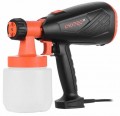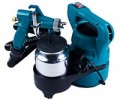Power consumption
The power consumed by the operation of an electric tool (see "Type").
Most modern spray guns, even performant ones, have a rather low power: for example, models
with more than 1 kW are extremely rare, and in most cases, power consumption does
not exceed 500 W at all. So when connecting such equipment to sockets, there are usually no problems; only single units of high performance, requiring 3.5 kW or more, have to be connected according to special rules (directly to the shield). In other cases, data on power consumption is most often not needed for normal use and may be required only for specific tasks — for example, to calculate the load on an autonomous generator.
Paint consumption
Consumption of paint or other material (for example, mortar for plaster) when the spray gun is operating in normal mode.
The higher the flow rate, the more material the tool can apply per unit of time, the better it is suitable for processing large areas and for applying thick coatings. On the other hand, not all types of work require high productivity, and sometimes relatively low consumption is optimal. Detailed recommendations on this subject for different situations can be found in special sources.
Maximum viscosity
The maximum viscosity of the paint or other working material at which the spray gun is able to work normally. Specified in DIN units; a certain DIN in this case is the number of seconds it takes for a standard volume of paint (usually 100 mL) to pour out of a funnel with a strictly defined pour hole diameter (usually about 4 mm). Such a funnel (viscometer) can be supplied with the spray gun, but if necessary, it can be purchased separately.
Thus, the larger the DIN, the more viscous the composition is. And the larger the number indicated in the characteristics of the spray gun, the wider its capabilities, the thicker liquids can be poured into it without fear of clogging and breakage. At the same time, it should be taken into account that in fact it is not so often necessary to work with thick liquids — on the contrary, excessive viscosity worsens the quality of the coating, leads to streaks and increases the drying time. For example, most enamels and oil paints are used at a viscosity of about 20 DIN, latex paints up to 45 DIN, etc. General recommendations on this matter can be found in special sources, and specific ones can be found on the packaging of a particular brand of paint or other composition.
Nozzle size
The diameter of the nozzle at the outlet of the spray gun.
It is from this nozzle that paint or other working material comes out. And the productivity and spot size at the exit depend on the diameter. Accordingly, larger nozzles are better suited for processing large surfaces, while smaller nozzles provide greater precision and accuracy. Thus, this parameter is directly related to the type of device (see above). There are also
spray guns with a replaceable nozzle, when more than one nozzle is provided in the kit, which expands the possibilities of using the device.
Container volume
The total volume of the paint reservoir supplied with the gun.
Large tank, on the one hand, allows you to "charge" a lot of material and work for a long time. On the other hand, it increases the size and weight of the device; and a large amount of paint will also weigh accordingly (although for models with a separate tank location - see above - this is not critical). Therefore, the thinner and more delicate the work for which the spray gun is designed, the, as a rule,
the smaller the tank volume : for example, in airbrushes (see "View") it rarely exceeds 50 ml, and in plaster models, in turn, can be measured liters. Therefore, most models have a volume of no more than a liter, namely
500 ml,
600 ml,
700 ml,
800 ml,
1000 ml.
Tank material
The material from which the complete reservoir of the spray gun is made.
— Plastic. Plastic is characterized by a combination of low cost with lightness and reliability. It is somewhat inferior to metal in strength, however, in the case of tanks for spray guns, this is not critical; in addition, the plastic tank can be made transparent, which makes it easier to keep track of the paint level. Thanks to all this, plastic is found in devices of all types and price categories. Among its shortcomings, sensitivity to certain types of solvents can be noted; however, there are resistant varieties of plastic that are practically devoid of this feature.
—
Metal. The main advantage of metal tanks is high strength and reliability. On the other hand, they are noticeably more expensive and heavier than plastic ones, and besides, they are not transparent (at best, a built-in indicator in the form of a window can be provided). Because of this, the metal is less common.
— Glass. The glass reservoirs are transparent and allow you to easily control the amount of remaining paint. In addition, this material is chemically inert and compatible with almost any working substance. However, glass has a serious drawback — fragility, which is why it has not received much distribution and is found only in some models of airbrushes (see "View").
Remote compressor
The presence of a
remote compressor in the design of the spray gun.
This feature means that, firstly, the unit is equipped with its own compressor (that is, it is electrical, see "Type"), and secondly, this compressor (or pump for airless spraying) is made separately from the sprayer and is connected to it special hose. Thanks to this design, the atomizer itself is as light and compact as possible, which is especially important for large volumes of work or for delicate work that requires maximum precision and accuracy. In light of the latter, all electric airbrushes (see "View") are equipped with remote compressors, although this feature is also found in other types of spray guns — in particular, this design is mandatory for paint stations (see ibid.).

